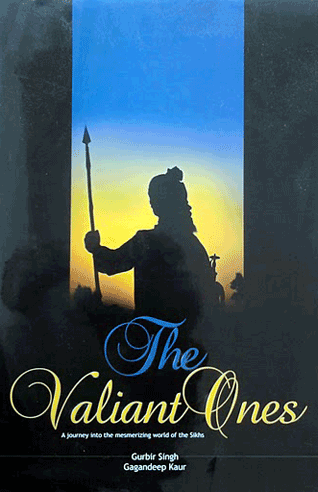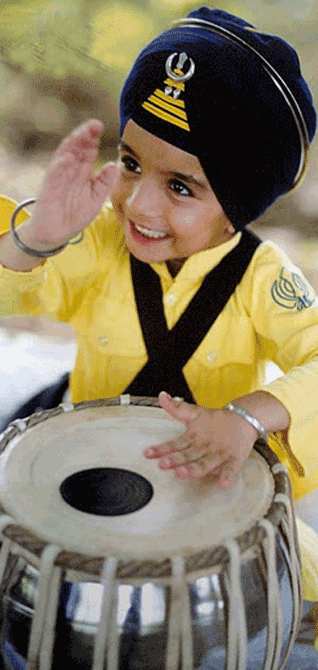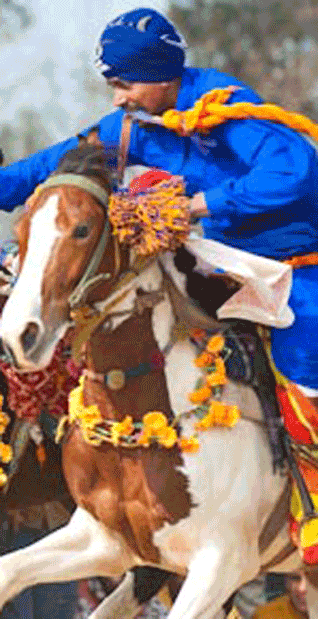Columnists
The Valiant Ones:
A New Book on The Nihangs
A Book Review by KHUSHWANT SINGH [Chandigarh]
‘The Valiant Ones - A journey Into The Mesmerizing
World of the Sikhs’, recently gifted to me by my publisher friend Gurmant Singh, proprietor of Lahore
Book House, is the latest offering on the Nihangs.
Authored by Gurbir Singh and Gagandeep Kaur, this 155-page coffee table book offers an attractive visual and print journey to capture the lives of a people who are fast fading away, their way of life, culture, language and valour being gobbled by a single word called ‘modernism’.
I have no idea about the background of the authors except that Gurbir Singh who straddles two continents spent almost three years living with the Nihangs. As for the charming Gagandeep Kaur - that’s what I can make out from the picture - has a background in fashion, travel and literature.
The term 'Nihang', according to the authors, could be from Persian, meaning alligator or sword. However, it could also be a derivative of the Sanskrit word Nihsanka meaning fearless or carefree.
The book also gives accounts about the origin of the dress-code of the Nihangs, one of them being being attributed to a son of the Tenth Master - Baba Fateh Singh. The authors claim that Baba Fateh Singh had once appeared in front of his father dressed in a blue chola, a line girdle fastened around his waist and a large blue turban with a farla (piece of cloth forming a plume) which had enticed Guru Gobind Singh to comment, "It is a dress fit for Akalis, the Soldiers of God!" [Nihangs were then known as Akalis.)
Having grown up with images of Nihangs wearing turbans almost half a quintal in weight, and a length that would even put to shame the Patwari’s (revenue officer) zareeb (measuring chain), the chapter on turbans quickly unravels the mystery for me.
Called dumaala, the Nihang turban has many dimensions to it, unlike the standard turban and fifti the average Sardar wears today. The Nihang turban is made up of a farla, bunga, chakkar, khanda, toda, singhi and dumala. The bunga or the pillar is the topmost part of the turban and tied separately.
The standard bunga is usually 2.5 m. But should a Nihang want to create a farla or a plume on the top, the length doubles (5m). According to the book, one Baba Swaranjit Singh uses 6m single length for his bunga and a separate 11m of rubia voile for his dumaala.
“Nihangs entwine their long hair with the turban cloth after securing five symbolic weapons in the hair. The dumaala is effective in protecting the head from sword cuts, especially when adorned with chakkars (quoits) and toda (20m long steel wire).” Phew.
As I flip through the pages further, the chapters take me through various aspects of the nihangs - their language, training in weaponry, weapons , spirituality, horses, festivals, daily routine, children, but I stop - for no particular reason, I assure you - at the chapter on shardai, popularly called deg or sukhnindan (treasure of comfort) in nihang parlance. Contrary to poular belief that Nihangs prepare this with a high measure of cannabis, the authors record that the Nihangs use only moderate level of leaves, but used high dosages in olden times as it acted as morphine to help numb the pain of battle-wounds.
The book also provides a perfect recipe of shardai, should someone want to use it for spicing up Holi.
Though a bit overpriced at Rs. 3000, yet in a crowded space - as many coffee-table offerings on Nihangs occupy huge shelf spaces in book stores - the authors have managed to keep their heads afloat. The drawbacks are camouflaged by the sheer love and passion that has gone into putting together this journey of the Nihangs.
[Courtesy: Hindustan Times. Edited for sikhchic.com]
September 17, 2011
Conversation about this article
1: Baldev Singh (Bradford, United Kingdom), September 17, 2011, 1:47 PM.
Nihangs played a decisive role in the defeat of the Mughals but unfortunately became a 'law unto themselves', with drug taking and factional fighting and lack of effective leadership - things that effect many in the larger community today. We need a brave new new generation of decent, discrimination-free people, free from the influence of caste-based hatred and self-centred agendas.
2: Swarnjit Singh (Punjab), September 18, 2011, 12:48 PM.
The authors have done a marvelous job of documenting and preserving. "The Valiant Ones" sheds light on the glorious history and heritage of the Sikhs. It is an encyclopedic reference for all ages. For once the Nihangs have been presented in the right light ... not as a sect but the original form of the Khalsa. To quote the authors: 'There is a Nihang waiting to be discovered in every Sikh's persona. There is a Nihang resident in every Punjabi's conscience.'
3: Baldev Singh (Bradford, United Kingdom), September 18, 2011, 3:48 PM.
Recently at a restaurant in Karol Bagh, Delhi, I was approached by two young 'handsome' Sikh men wearing the attire of Nihangs and one of them asked me to buy them lunch, and give him money because he wanted to buy a horse. I reminded him that one of the basic tenets of Sikhi was kirat karni, not being petty beggars or using the uniform or identity of the Khalsa to avoid working. No sects are allowed in Sikhi and neither is begging or bullying.
4: Karandeep Singh (Chandigarh, Punjab), September 18, 2011, 5:08 PM.
Sardar Baldev Singh, I shall quote from "The Valiant Ones" (page 125): "Nihang Singhs nurture a live tradition engendering immense pride in our glorious heritage. They maintain our places of worship, spread the Gurus' word through their extensive travels, are a virtual museum on the move, inspire us with their skill at horsemanship. Swashbuckling exponents of shastar vidya, they spend a lifetime of meditation, training and good deeds. There is need to revere our warrior saints, preserve their way of life and show them our appreciation. In our failure to understand the Nihang Singhs we occasionally brand the pitiable imposters stationed outside gurdwaras [or restaurants in Karol Bagh] as Nihangs."
5: Baldev Singh (Bradford, United Kingdom), September 18, 2011, 7:37 PM.
Any sub-group within Sikhi is completely futile and a danger and disaster to the nation.
6: N. Singh (Canada), September 18, 2011, 9:59 PM.
The real danger to Sikhi is casteism. I have seen it used to support the most heinous of crimes.
7: Baldev Singh (United Kingdom), September 19, 2011, 7:03 PM.
The message is simple ... those who wear the Punj Kakkaars, but behave in unSikh-like manner, merely bring the entire community to disrepute.
8: Avninder Singh Cheema (Chandigarh, Punjab), September 24, 2011, 9:44 AM.
I was one of the first persons to read this book and had the honor of interacting with S. Gurbir Singh, a co-author and photographer of this book. According to him, the main aim of working on this book was to show the general people that the Nihang Singhs are no different from us, it's just the way they have chosen to live their life on certain principles. It took him three years to compile the book and the results are indeed very fruitful. The contents, photography, printing and the overall quality is of a very high standard.
9: Sana Singla (Mohali, Punjab), November 07, 2011, 2:21 AM.
Great information provided. I appreciate your work.





